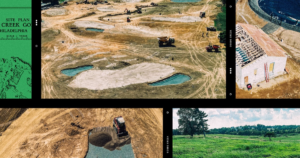Few things are as soothing on a hot summer’s day as a walk through a beautiful botanical garden, but these aren’t just oases of calm. As climate collapse fuels rising temperatures, it may be essential to moderate the heat in the streets around them.
A comprehensive review of research on the heat-mitigating effects of green spaces during heatwaves found that botanical gardens are the most effective. It’s a finding the team at the Global Center for Clean Air Research (GCCAR) hopes will inform policymakers planning cities for a warming world.
They are setting up the Reclaim Network Plus, a global web of planners, academics, city officials, charities and businesses who will look at the evidence around the benefits of green and blue space in urban planning.
This particular research found that sites such as the Chelsea Physic Garden and Royal Botanic Gardens at Kew in London, or the Gardens by the Bay in Singapore, reduced air temperatures in the city streets around them by an average of 5C during heat waves.
Urban parks and wetlands have a similar effect, and even green walls, street trees and playgrounds have been found to significantly moderate temperatures. “We’ve known for some time that green spaces and water can cool cities,” said GCCAR director Prof Prashant Kumar, the study’s lead author.
“However, this study gives us the most comprehensive picture yet. What’s more – we can explain why. From trees that provide shade, to evaporating water that cools the air.
“The whole idea of the network is to promote the implementation of blue and green infrastructure in urban environments,” he said. But the problem they encountered is a lack of systematic research into the types of different urban green spaces, and their impact on the environments around them.
“So the idea of this article was to actually put the science in terms of what exists in terms of green and blue spaces in cities, what information is available, where are the areas where there is a lack of research.. . and then if there is urban planning then what kind of evidence base can they use to better plan new green spaces.”
Local factors played an important role, but overall the review found that the larger the park, the greater the cooling effect – at least up to a point. It also found that cities can unlock more benefits by linking green spaces together in “green corridors”.
“This will help city planners around the world to meet the challenges of global warming,” Kumar said. “By implementing just some of the measures we describe, cities can become more resilient, and their citizens can also be healthier and happier.”
A co-author of the report, Prof Maria de Fatima Andrade from the Department of Atmospheric Sciences at the University of São Paulo, Brazil, said: “Our paper just confirms how many ways there are to stay cool. But it also reveals how much work remains to be done. Institutions around the world need to invest in the right research – because what is very clear from our study is that there is no one-size-fits-all solution. It depends on what works for your community.”
Average cooling effect / variation
Botanical Gardens: -5.0C / -2.2C to -10C
Wetlands: -4.7C / -1.2C to -12C
Rain gardens: -4.5C / -1.3C to -7C
Green walls: -4.1C / -0.1C to -18C
Street trees: -3.8C / -0.5C to -12C
City farms: -3.5C / -3.0C to -3.9C
Parks: -3.2C / -0.8C to -10C
Reservoirs: -2.9C / -1.8C to -5C
Playgrounds: -2.9C / -2.8C to -3C





